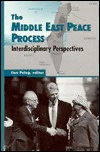
The Middle East Peace Process: Interdisciplinary Perspectives PDF
Preview The Middle East Peace Process: Interdisciplinary Perspectives
The Middle East Peace Process SUNY Series in Israeli Studies Russell Stone, editor Edited by ILAN PELEG The Middle East Peace Process Interdisciplinary Perspectives STATE UNIVERSITY OF NEW YORK PRESS Published by State University of New York Press, Albany © 1998 State University of New York All rights reserved Printed in the United States of America No part of this book may be used or reproduced in any manner whatsoever without written permission. No part of this book may be stored in a retrieval system or transmitted in any form by any means including electronic, electrostatic, magnetic tape, mechanical, photocopying, recording, or otherwise without the prior permission in writing of the publisher. For information, address the State University of New York Press, State University Plaza, Albany, NY 12246 Production design by David Ford Marketing by Dana E. Yannlovich Library of Congress Cataloging-In-Publication Data The Middle East peace process: interdisciplinary perspectives I edited by Han Peleg. p. cm. - (SUNY series in Israeli studies) Includes bibliographical references and index. ISBN 0-7914-3541-5. - ISBN 0-7914-3542-3 (pbk.) 1. Jewish-Arab relation-1973- 2. Israel-Politics and government. 3. Palestinian Arabs-Politics and government. 4. Israel-Foreign relations-Jordan. 5. Jordan-Foreign relations -Israel. I. Peleg, Han, 1944- II. Series. DS119.7.M471784 1997 327.569405695--dc21 97-1208 CIP r97 10 9 8 7 6 5 4 3 2 1 Dedicated to the memory of Yitzhak Rabin and Anwar Sadat Two soldiers who fell on the way to peace in the Middle East Contents Preface ix PART I. HISTORICAL PERSPECTIVES 1. The Israeli-Palestinian Peace Process in Historical Perspective 3 Laura Zittrain Eisenberg and Neil Caplan 2. The Historians' Debate in Israel and the Middle East Peace Process 21 Mordechai Bar-On PART II. PEACE AND ISRAELI ATTITUDES 3. The Peace Process and Competing Challenges to the Dominant Zionist Discourse 41 Myron J. Aronoff and Pierre M. Atlas 4. Two People Apart: Israeli Jews' and Arabs' Attitudes Toward the Peace Process 61 Tamar S. Hermann and Ephrain Yuchtman-Yaar PART III. PEACE AND ISRAELI INSTITUTIONS 5. Political Institutions and Conflict Resolution: The Israeli Supreme Court and the Peace Process 87 Gad Barzilai 6. The Peace Process and Societal-Military Relations in Israel 107 Stuart A. Cohen viii THE MIDDLE EAST PEACE PROCESS PART IV. PEACE AND THE PALESTINIANS 7. The PLO and the Peace Process 123 JoAnn DiGeorgio-Lutz 8. Palestinian Christians and the Peace Process: The Dilemma of a Minority 141 Daphne Tsimhoni PART V. JORDAN AND PEACE 9. Jordan in the Middle East Peace Process: From War to Peace with Israel 161 Curtis R. Ryan 10. Israel's "Jordanian Option": A Post-Oslo Reassessment 179 Aharon Klieman PART VI. PEACE AND ECONOMICS 11. Labor in a Peaceful Middle East: Regional Prosperity or Social Dumping? 199 Guy Mundlak 12. The Peace Dividend: The Economy ofIsrael and the Peace Process 223 Ofira Seliktar Epilogue: The Peace Process and Israel's Political Kulturkampf 237 Ilan Peleg References 265 About the Contributors 291 Index 295 Preface The peace process in the Middle East has been pursued, in one fonn or another, for thirty years. Thus, a short time after the 1967 war, intensive negotiations on the language of a Security Council resolution began, leading eventually to the famed Resolution 242. Nevertheless, for most of the last three decades the peace process was frozen, showing only on rare occasions (e.g., at Camp David in 1978) signs of life. In late August 1993, this paralysis and inaction came to an abrupt end. Rumors about an imminent breakthrough in the Israeli-Palestinian negotiations spread and were quickly substantiated. It became clear that the Israelis and the Arabs (and specifically the Palestinians) had decided to focus on the peace making process and to move, however gradually, from a condition of an on going conflict, erupting on occasion into open warfare, to a condition of peace. The dramatic acceleration of the peace process was accompanied by what might be appropriately called a flood of analysis of and reflection about the meaning of the historic event. Journalists, academics, politicians, editorialists, and others wrote over the last few years thousands of articles and millions of words about the Middle East peace process. Yet, all of the analysts and commentators ran into three major problems which made their observations, in reality or by appearance, overly speculative: First, the problem of perspective. Most analyses of the Middle East peace process have been offered very close to the events themselves or even immediately following the events. Although that kind of instant analysis could be fascinating, it often lacks the rigor emanating from a larger view, a view which is possible only with the passage of time and only after some of the events have come to an end; Second, the problem of the complexity of the peace process, com pounded the difficulties of the instant analyst. Factors such as the sheer ix
